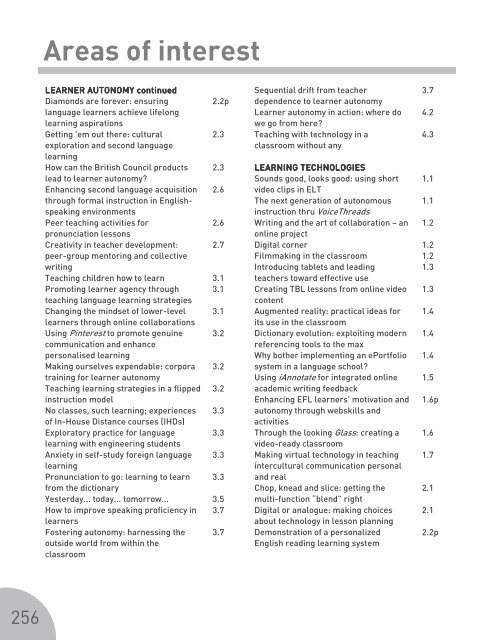Create successful ePaper yourself
Turn your PDF publications into a flip-book with our unique Google optimized e-Paper software.
Areas of interest<br />
LEARNER AUTONOMY continued<br />
Diamonds are forever: ensuring<br />
language learners achieve lifelong<br />
learning aspirations<br />
Getting 'em out there: cultural<br />
exploration and second language<br />
learning<br />
How can the British Council products<br />
lead to learner autonomy?<br />
Enhancing second language acquisition<br />
through formal instruction in Englishspeaking<br />
environments<br />
Peer teaching activities for<br />
pronunciation lessons<br />
Creativity in teacher development:<br />
peer-group mentoring and collective<br />
writing<br />
Teaching children how to learn<br />
Promoting learner agency through<br />
teaching language learning strategies<br />
Changing the mindset of lower-level<br />
learners through online collaborations<br />
Using Pinterest to promote genuine<br />
communication and enhance<br />
personalised learning<br />
Making ourselves expendable: corpora<br />
training for learner autonomy<br />
Teaching learning strategies in a flipped<br />
instruction model<br />
No classes, such learning; experiences<br />
of In-House Distance courses (IHDs)<br />
Exploratory practice for language<br />
learning with engineering students<br />
Anxiety in self-study foreign language<br />
learning<br />
Pronunciation to go: learning to learn<br />
from the dictionary<br />
Yesterday... today... tomorrow...<br />
How to improve speaking proficiency in<br />
learners<br />
Fostering autonomy: harnessing the<br />
outside world from within the<br />
classroom<br />
2.2p<br />
2.3<br />
2.3<br />
2.6<br />
2.6<br />
2.7<br />
3.1<br />
3.1<br />
3.1<br />
3.2<br />
3.2<br />
3.2<br />
3.3<br />
3.3<br />
3.3<br />
3.3<br />
3.5<br />
3.7<br />
3.7<br />
Sequential drift from teacher<br />
dependence to learner autonomy<br />
Learner autonomy in action: where do<br />
we go from here?<br />
Teaching with technology in a<br />
classroom without any<br />
LEARNING TECHNOLOGIES<br />
Sounds good, looks good: using short<br />
video clips in ELT<br />
The next generation of autonomous<br />
instruction thru VoiceThreads<br />
Writing and the art of collaboration – an<br />
online project<br />
Digital corner<br />
Filmmaking in the classroom<br />
Introducing tablets and leading<br />
teachers toward effective use<br />
Creating TBL lessons from online video<br />
content<br />
Augmented reality: practical ideas for<br />
its use in the classroom<br />
Dictionary evolution: exploiting modern<br />
referencing tools to the max<br />
Why bother implementing an ePortfolio<br />
system in a language school?<br />
Using iAnnotate for integrated online<br />
academic writing feedback<br />
Enhancing EFL learners' motivation and<br />
autonomy through webskills and<br />
activities<br />
Through the looking Glass: creating a<br />
video-ready classroom<br />
Making virtual technology in teaching<br />
intercultural communication personal<br />
and real<br />
Chop, knead and slice: getting the<br />
multi-function “blend” right<br />
Digital or analogue: making choices<br />
about technology in lesson planning<br />
Demonstration of a personalized<br />
English reading learning system<br />
3.7<br />
4.2<br />
4.3<br />
1.1<br />
1.1<br />
1.2<br />
1.2<br />
1.2<br />
1.3<br />
1.3<br />
1.4<br />
1.4<br />
1.4<br />
1.5<br />
1.6p<br />
1.6<br />
1.7<br />
2.1<br />
2.1<br />
2.2p<br />
256


